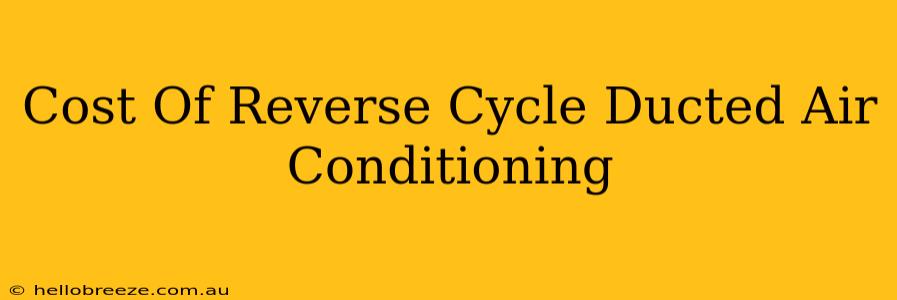Thinking about installing reverse cycle ducted air conditioning? It's a significant investment, offering year-round comfort, but understanding the cost is crucial. This guide breaks down the factors influencing the price of a reverse cycle ducted system, helping you budget effectively.
Factors Affecting the Cost of Reverse Cycle Ducted Air Conditioning
Several key factors determine the final cost of your reverse cycle ducted air conditioning installation. These include:
1. System Size and Capacity:
This is arguably the biggest factor. Larger homes or those with poor insulation require more powerful systems, significantly increasing the upfront cost. The size of your home and the number of zones you want to cool and heat directly impact the cost. A qualified installer will conduct a heat load calculation to determine the appropriate system size. Don't skimp here – an undersized system will struggle, increasing your running costs and potentially shortening its lifespan.
2. Brand and Model:
Brands vary in price and features. Established brands often come with a higher price tag but may offer superior efficiency, longer warranties, and better customer support. Research different brands and models, comparing features and energy efficiency ratings (like SEER and EER) to make an informed choice.
3. Installation Complexity:
Installation complexity significantly affects the overall cost. Factors like:
- Accessibility: Difficult-to-reach areas or existing obstructions can increase labor costs.
- Ducted System Design: The layout of your ducts, the number of vents, and the required ductwork length affect the installation time and cost. A complex ductwork design will inevitably be more expensive.
- Existing Infrastructure: If you require significant modifications to your existing infrastructure, it will add to the expense.
4. Location:
Your geographical location influences the cost of installation. Labor rates and material costs vary between regions, with metropolitan areas generally being more expensive than regional areas.
5. Additional Features:
Optional features like:
- Smart home integration: Allows for remote control and scheduling.
- Zoning: Enables independent temperature control in different areas of your home.
- Air purification: Improves indoor air quality.
All these extras add to the total cost. Consider your needs and budget when selecting features.
Estimating the Cost
While it's difficult to give a precise figure without a professional assessment, you can expect the cost of reverse cycle ducted air conditioning to range from several thousand dollars to upwards of $15,000 or more. The average cost for a standard installation is likely to fall within a range of $6,000 to $12,000.
Always get multiple quotes from reputable installers. This allows you to compare prices, features, and warranties, ensuring you're getting the best value for your money.
Saving Money on Installation
There are ways to potentially reduce the overall cost:
- Consider off-peak installation: Installers may offer discounted rates during the off-season.
- Shop around for financing options: Some companies offer financing plans to make the upfront cost more manageable.
- Explore government incentives: Check for any available rebates or incentives from your state or local government for energy-efficient upgrades.
- Improve home insulation: Better insulation reduces the load on your air conditioning system, potentially allowing you to choose a smaller, less expensive unit.
Conclusion
Investing in reverse cycle ducted air conditioning is a significant decision, impacting both your comfort and your finances. By carefully considering the factors discussed above and obtaining multiple quotes, you can make an informed choice and ensure a smooth installation process. Remember, while initial costs are a factor, the long-term energy savings and increased comfort make it a worthwhile investment for many homeowners.

